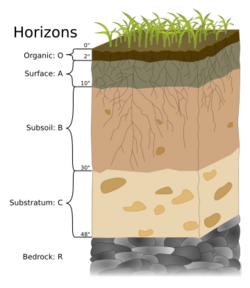Earth:Bedrock


In geology, bedrock is solid rock that lies under loose material (regolith) within the crust of Earth or another terrestrial planet.
Definition
Bedrock is the solid rock that underlies looser surface material.[1] An exposed portion of bedrock is often called an outcrop.[2] The various kinds of broken and weathered rock material, such as soil and subsoil, that may overlie the bedrock are known as regolith.[3][4]
Engineering geology
The surface of the bedrock beneath the soil cover (regolith) is also known as rockhead in engineering geology,[5][6] and its identification by digging, drilling or geophysical methods is an important task in most civil engineering projects. Superficial deposits can be very thick, such that the bedrock lies hundreds of meters below the surface.[7]
Weathering of bedrock
Exposed bedrock experiences weathering, which may be physical or chemical, and which alters the structure of the rock to leave it susceptible to erosion. Bedrock may also experience subsurface weathering at its upper boundary, forming saprolite.[8]
Geologic map
A geologic map of an area will usually show the distribution of differing bedrock types, rock that would be exposed at the surface if all soil or other superficial deposits were removed. Where superficial deposits are so thick that the underlying bedrock cannot be reliably mapped, the superficial deposits will be mapped instead (for example, as alluvium).[9]
See also
References
- ↑ Jackson, Julia A., ed (1997). "Bedrock". Glossary of geology. (Fourth ed.). Alexandria, Virginia: American Geological Institute. ISBN 0922152349.
- ↑ Jackson 1997, "Outcrop".
- ↑ Jackson 1997, "Regolith".
- ↑ Allaby, Michael (2013). "Regolith". A dictionary of geology and earth sciences (Fourth ed.). Oxford: Oxford University Press. ISBN 9780199653065.
- ↑ Price, David George (2009). "The Basis of Engineering Geology". in de Freitas, Michael H.. Engineering Geology: Principles and Practice. Springer. pp. 16. ISBN 978-3540292494. https://books.google.com/books?id=SXHyRIEryEcC&pg=PA16.
- ↑ McLean, A.C.; Gribble, C.D. (9 September 1985). Geology for Civil Engineers (Second ed.). CRC Press. p. 113. ISBN 978-0419160007. https://books.google.com/books?id=ayPapNgD1hMC&q=bedrock+contour+map+rockhead&pg=PA113.
- ↑ Swinford, E. Mac (2004). "What the glaciers left behind—the drift-thickness map of Ohio". Ohio Geology (Ohio Department of Natural Resources, Division of Geological Survey) (1): 1, 3–5. https://geosurvey.ohiodnr.gov/portals/geosurvey/PDFs/Newsletter/2004No.1.pdf. Retrieved 12 September 2012.
- ↑ Lidmar-Bergström, Karna; Olsson, Siv; Olvmo, Mats (January 1997). "Palaeosurfaces and associated saprolites in southern Sweden". Geological Society, London, Special Publications 120 (1): 95–124. doi:10.1144/GSL.SP.1997.120.01.07. Bibcode: 1997GSLSP.120...95L. http://sp.lyellcollection.org/cgi/content/abstract/120/1/95. Retrieved April 21, 2010.
- ↑ "Digital Geology – Bedrock geology theme". British Geological Survey. https://www.bgs.ac.uk/products/digitalmaps/digmapgb_solid.html.
Further reading
- Rafferty, John P.. "Bedrock". Encyclopædia Britannica. https://www.britannica.com/science/bedrock. Retrieved 1 April 2019.
- Harris, Clay (2013). "Bedrock". in Lerner, K. Lee; Lerner, Brenda Wilmoth. The Gale Encyclopedia of Science. 1 (5th ed.). Farmington Hills, MI: Cengage Gale. pp. 515–516.
External links
 |

